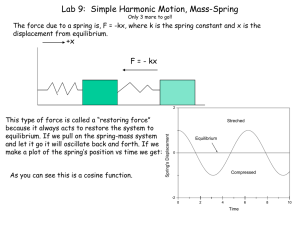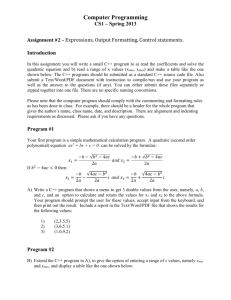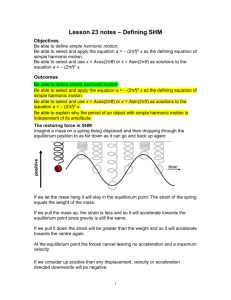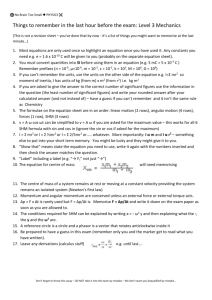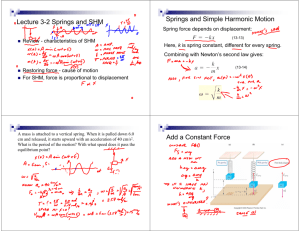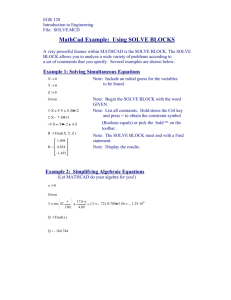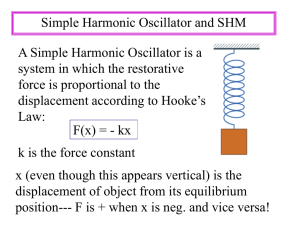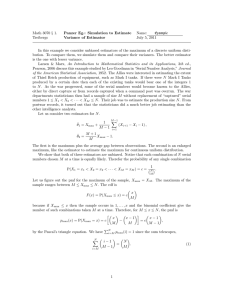Lecture 2
advertisement
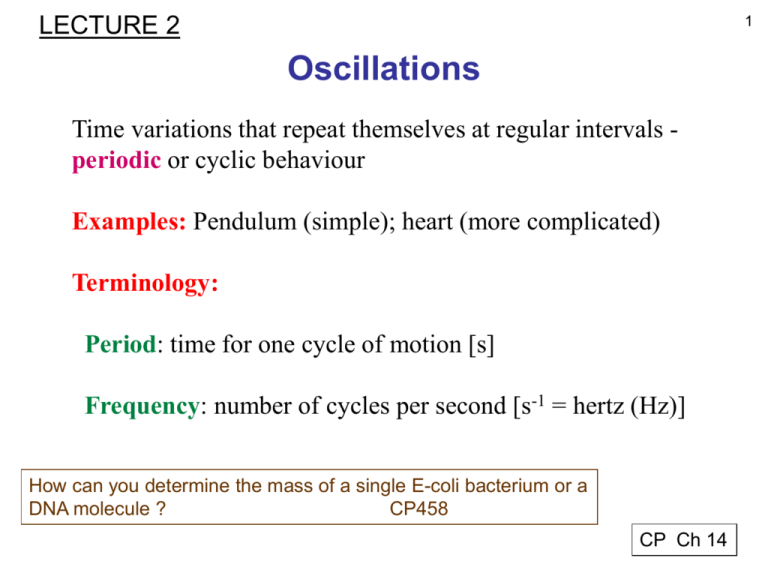
1 LECTURE 2 Oscillations Time variations that repeat themselves at regular intervals periodic or cyclic behaviour Examples: Pendulum (simple); heart (more complicated) Terminology: Period: time for one cycle of motion [s] Frequency: number of cycles per second [s-1 = hertz (Hz)] How can you determine the mass of a single E-coli bacterium or a DNA molecule ? CP458 CP Ch 14 2 Signal from ECG period T Period: time for one cycle of motion [s] Frequency: number of cycles per second [s-1 = Hz hertz] 1 kHz = 103 Hz 106 Hz = 1 MHz 1GHz = 109 Hz CP445 3 Brightness Example: oscillating stars Time CP445 4 Simple harmonic motion SHM x=0 spring Fe Fe k x restoring force x +X • object displaced, then released • objects oscillates about equilibrium position • motion is periodic • displacement is a sinusoidal function of time (harmonic) T = period = duration of one cycle of motion f = frequency = # cycles per second • restoring force always acts towards equilibrium position CP447 5 Motion problems – need a frame of reference origin 0 equilibrium position displacement x [m] velocity v [m.s-1] - xmax Vertical hung spring: gravity determines the equilibrium position – does not affect restoring force for displacements from equilibrium position – mass oscillates vertically with SHM Fe = - k y + xmax acceleration a [m.s-2] Force Fe [N] CP447 6 Connection SHM – uniform circular motion w = dq/dt w = 2p / T amplitude A A T=1/f f=1/T w=2pf w=2 p / T One cycle: period T [s] Cycles in 1 s: frequency f [Hz] q - -1 ] angular frequency w [rad.s CP453 7 SHM & circular motion Displacement is sinusoidal function of time t x xmax cos 2p xmax cos 2p f t xmax cos w t T uniform circular motion radius A, angular frequency w v A xmax q wt x 2p w 2p f T x component is SHM: x A cos w t xmax A CP453 8 Simple harmonic motion displacement T amplitude xmax T time T Displacement is a sinusoidal function of time t x x max cos2p x max cos2pft x max coswt T By how much does phase change over one period? CP451 9 Simple harmonic motion x xmax cos w t v xmaxw sin w t a xmaxw 2 cos w t a w 2 x equation of motion substitute xmax A m a k x k 1 w f m 2p (restoring force) k m T 2p m k oscillation frequency and period CP457 10 Simple harmonic motion a w 2 x At extremes of oscillations, v = 0 When passing through equilibrium, v is a maximum acceleration is p rad (180) out of phase with displacement 2 v 2 xmax w 2 sin 2 w t 2 xmax w 2 (1 cos2 w t ) 2 w 2 ( xmax x2 ) 2 v w ( xmax x2 ) CP457 11 SHM position x 10 0 -10 0 10 20 30 40 50 60 70 80 90 100 0 10 20 30 40 50 60 70 80 90 100 0 10 20 30 40 50 time t 60 70 80 90 100 velocity v 5 0 acceleration a -5 1 0 -1 How do you describe the phase relationships between displacement, velocity and acceleration? CP459 12 Problem 2.1 If a body oscillates in SHM according to the equation x 5.0cos(0.40 t 0.10) m where each term is in SI units. What are (a) the amplitude (b) the frequency and period (c) the initial phase at t = 0? (d) the displacement at t = 2.0 s? 13 Problem 2.2 An object is hung from a light vertical helical spring that subsequently stretches 20 mm. The body is then displaced and set into SHM. Determine the frequency at which it oscillates. 14 Answers to problems 2.1 5.0 m 0.064 Hz 2.2 w = 22 rad.s-1 16 s f = 3.5 Hz 0.10 rad 3.1 m
